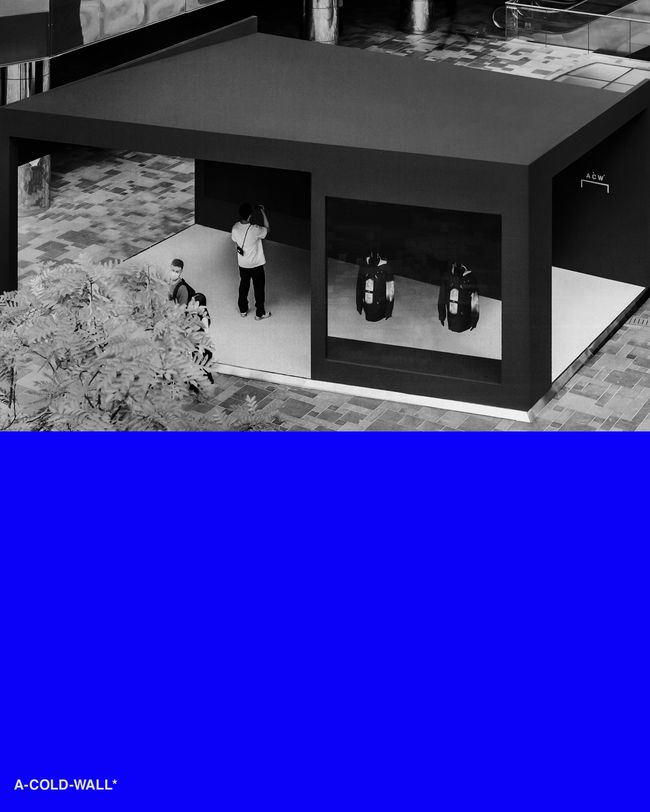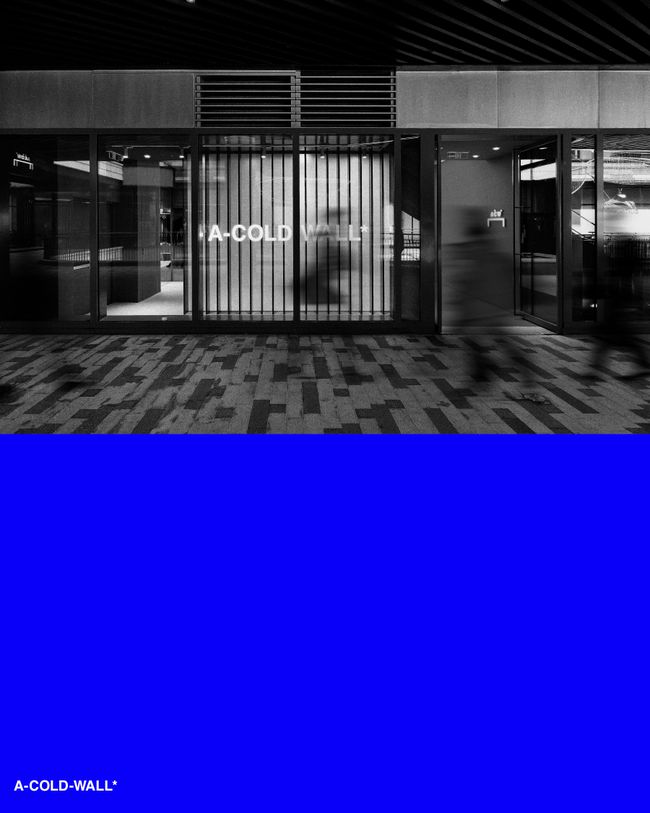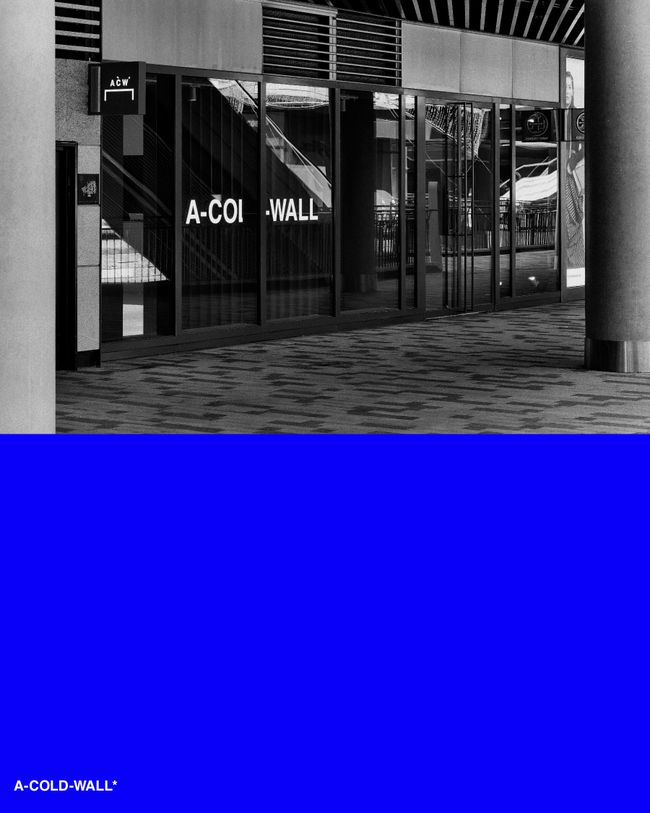Commercial Proximities
Jack Self in discussion with Samuel Ross, designer and director of A-COLD-WALL*, on how commercial design builds a contemporary commons
- JS
- When the Tate Modern opened in 2000, the fashion world was very elitist, very small, while the art world was considered a primary driver of culture. But I think that has inverted in the last ten years. I don’t think anyone today looks to artists to point to the future of society and culture in the same way that they look to designers, especially fashion and product designers. Is commercial design the main driver of contemporary culture?
- SR
- Within the context of late capitalism, as postmodernity becomes a bit more steadfast, I think that the physical rhythm of the commercial design process offers the practitioner more structure to be able to forecast, forward plan, and develop a strategy to implement elements of storytelling in commercial vehicles. So, to a degree I’d say yes. I also think that a generation of practitioners who have come out of design school in the last decade were still trained based on a curriculum of Superstudio and Lella and Massimo Vignelli. The radical Italian approach that held the design world by a conceptual chokehold in the 1960s and 1970s didn’t have enough of the fiscal backing or equity to be able to take execute some of their concepts. Whereas today, open-source LLCs can be started overnight. This intervention of entrepreneurial agency within design training and artistic practice has almost evolved into a kind of expectation. And that possibility is giving the artist, whether they wear the mask of an architect or a fashion designer or an industrial designer, far more autonomy and control to be radical. Because there’s a plurality to design culture now. It doesn’t matter if it’s design with a big D or a small d, it’s far more plural.
- JS
- Is commercial success an equalizer? Is design today more inclusive and democratic?
- SR
- It is far more democratic than it has been over the past ten to 15 years. If I think about who design is for, it’s brilliant to see a wider or more anamorphic lens on the topic make good design accessible to more people, thus enhancing their relationship to design as well as expanding what it can offer. Is design more diverse today? Well, the British Design Council recently published their findings and reports for the 2022 annual calendar and fiscal year. And in terms of inclusivity and diversity, some of the statistics they revealed were stark and shocking. There’s clearly a lot of work to be done in terms of diversity. It’s not realistic to expect complete equality, because that’s not how postcolonial countries are built. But there can still be far more acknowledgment of design that feels more diverse. And I do believe we are going down that path. Even considering nominations for the Hublot Design Prize—until recently, it was nearly enough impossible to name notable industrial and graphic designers of colour that came through the British design or art system over the past 25 to 30 years. There are still a lot of changes to be made, but the Internet is facilitating a far more democratic way of achieving diversity in design culture.
- JS
- We often talk about the satisfaction of buying and owning, but is there a satisfaction and pride to making and selling a product?
- SR
- This question brings up a lot of conversations that I’ve had with close peers and friends over the past quarter. Those conversations have concerned the conflation of the designer with the consumer, which I find to be problematic. I think we are finding that a lot of designers are being crewed in to act as luxury consumers. And then they of course become a proxy for larger conglomerates.
I think there’s a correlation between the luxury consumer and how that persona is used almost as a conduit to filter and bring in new demographics to retail and design. This trend contrasts with the traditional role of a designer who operates with neutrality in what they design, versus veering too much into consumerism. And we all have our vices, but that has been huge recent shift— is a designer a designer, or is a designer now a luxury consumer? If we’re talking about the next era of fashion and influence, we need to start putting together a more cohesive image of what’s happening. - JS
- What you’re saying regarding the designer get pulled into LVMH, Kering, or similar transnational luxury conglomerates leads me to wonder how important independence is for you as a designer?
- SR
- I see creative expression as a freedom. And historically it’s a liberty that should’ve always been a default mode of being and producing, but this wasn’t always the case. You just need to think about Edo period feudal systems, or the period before the French Revolution, which didn’t necessarily afford an equal level of creative expression to everyone. We can even consider how parchment was only available to a particular segment of Europeans to write on. I’m not saying that those historical struggles are equivalent to what it means to have an NDA a not to be able to, let’s say, design a chair if you are only paid or contractually obliged to design shoes.
That idea of making and crafting and engineering—being able to take an intangible thought and materialize that into a physical expression—has power beyond any transactional system. It’s intrinsically what makes us human. So, to me, liberty and independence are synonymous, and I can’t see how one could separate the two.
- JS
- Is your commercial work driven by social objectives?
- SR
- I would say yes. I see far more good that can come from decentralizing and sharing opportunities and influence, by consolidating like-minded intentions rather than simply sitting on one’s laurels. If you have had the opportunity to achieve some type of commercial success, a feedback loop should be extended to those who collaborated and worked together to raise you into that position. This takes shape through radical hiring policies, grant programs, advisory boards, donations, and by building creative communities. Sometimes this happens by giving time to people and by being honest.
Sometimes my obligation is simply to tell the truth of what it may take to enter a system or to prepare someone to onboard into an industry or a particular position. The design world can be so transactional, point one being purchase, point two being conversion, and point three being scalability—to sever the social doesn’t feel morally correct. That’s my personal view. Some people only want to scale up, they want to take, and that’s fine. Because there’s not necessarily a right or wrong, but I do believe in just causes. And maybe that’s poetic and romantic, but I do believe in the just cause. - JS
- How important is physical retail space to your objectives?
- SR
- Physical space, retail space, liminal space, occupy the same function as the courtyard in Renaissance Venice. They are where all people, backgrounds, demographics, and communities coalesce and overlap. And they offer an opportunity to find common ground in the populace.
And I think that proximity can be conveyed and projected through retail design because of the oscillations of engagement that unfold within its physical spaces. During the lockdown and post-lockdown periods, social media has introduced a level of immediate saturation [for the consumer], which needs to be translated into physical space if it is to pull in an audience and new consumer base. And by immediate saturation I mean the relationship we have to the 4x5 ratio, 300 DPI, expectations in 1080 PI , expectations of image quality; that level of engagement with colour, shadow casting, and intensity must be exemplified in physical space if we’re talking about what retail can truly offer today. It must consider the temperature, the lighting, the wind speed, the elevation, the coarseness or juxtaposition of materials, the reverberations of sound. There’s a real opportunity for commercial spaces to become education centres. And I’m obsessed with that prospect.
Retail Apocalypse is curated by Fred Fischli and Niels Olsen. We have published interviews with designer Tadeáš Říha and Kateřina Frejlachová, fashion designer [Justin Louis] (https://www.cca.qc.ca/en/articles/87715/front-line-fashion), and creative director Samir Bantal. The exhibition is currently on view in the Hall Cases and Octagonal gallery and runs until 15 January 2023.


